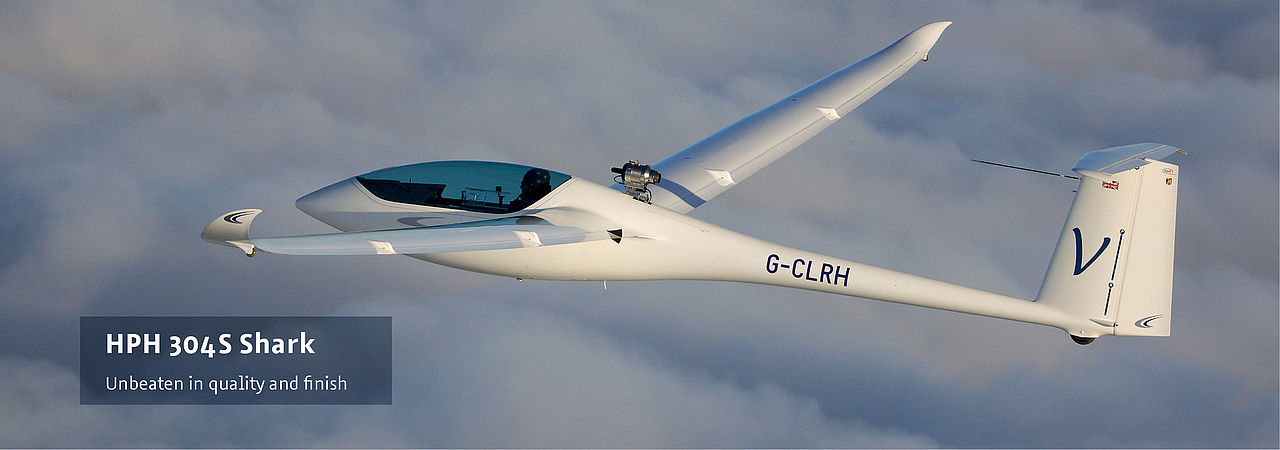
If you are interested about HpH 304 Shark and you want make a test flight or price inquiry please click here.
The all-new HPH 304S is a high-performance single-seated, flapped racing class sailplane. It is offered in a convertible wing configuration with long and short wingtip extensions allowing both 15- and 18-meter wingspans.
Not simply a face lift of an existing technology, but the very latest in a long study of what was, until now, the “State-of-the-Art”. The new HPH 304S prototype was flown on November 23rd 2006. Test pilot Ludek Kluger was surprised with the excellent characteristic of the new glider. He reported excellent flying quality from the first moment. Testing and development continued intensively. Today, we have a technically mature product that fits any pilot need.
The airfoil, only 13.2% thick, was designed mainly in order to reduce the influence of insect contamination on the flight performance. Towards the wing root the thickness increases to 16.4%, with special care to the wing root transition. The wing ends with an elliptically-formed leading edge and 3D curved wingtips are specially shaped to minimize the induced drag. Three-part flaperons through the whole wing span are set in the wing trailing edge. This provides the pilot with good handling and improved flight performance. The wing inner structure and its reinforcement result from detailed FEM calculations in combination with numerous break tests. The result is a carbon fiber structure that makes the cruising flight very comfortable and offers maximum performance in both strong and weak thermals. The water ballast is located in integral wing tanks of 180 liter capacity. There are additional ballast tanks in the tail and optionally in the fuselage. The maximum take-off weight of the 18m version is 600 kg, raising the maximum surface loading up to 50.8 kg/m2. This combination results in a gliding ratio of more than 51 at 125 km/h. Three-stage air brakes are a must to reach sufficient sink rate and allow landing at high glide path rates and at exact landing points. All steering units have automatic connections. This also applies to the ballast tanks, release controls and the slide-in wing end. Locking proceeds by means of a simple hinge, and the flaperon attachment is automatic as well. Our aerodynamically covered wingtip wheels are highly welcomed by pilots because they facilitate take-off and landing, and prevent damage. The design shows an attention to even the smallest detail, such as the elevator trailing edge being elliptically formed thanks to CNC technology. It corresponds in design with the wing ends improving the parallel reduction of induced drag. The elevator connection is automatic, the locking proceeds by use of a single pin. And the perfect functioning of the rudders in a Glasflugel 304 is already legend…
Numerous FEM calculations, break tests and crash simulations led to a new safety cockpit that can help to save life and to minimize damage. For example, the »Roger hook«, for safe emergency removal of the canopy, is an integrated standard in the solid frame.
The fuselage cutout is prepared for a power unit; which one depends on your individual preference: self-launcher (Solo 2625-01) or JET engine. The engine compartments and the fuel tanks are parts of the primary structure. In this manner we can carry out the installation of your desired engine version at any time.
Cockpit ergonomics was always one of the main quality features of Glasflugel 304 sailplanes. The safety cockpit of the 304S takes advantage of the proven concept. As a glider pilot you know how important the feeling of comfort and safety is during the flight. These attributes are achieved by, among other factors, the use of hiqh-quality materials. Take pleasure in the massive carbon aramid frame, superior and durable leather interior, sensibly designed instrument panel as well as hand hugging controls. All details are finished with special care – take a look at the control stick or canopy locks! Also pilots above 6ft tall find a very good seat position thanks to enough space for elbows and shoulders. And, of course, we can make adjustments and customizations to suit your specific needs.

Die heute am Markt befindlichen Antriebskonzepte für eigenstartfähige Segelflugzeuge sind prinzipiell ähnlich. Ein Propellerturm wird ausgefahren und der Motor danach gestartet. Nach getaner Arbeit wird der Turm wieder eingeklappt.
Die Umsetzung, die Bedienkonzepte sowie die verwendeten Motoren sind aber doch recht unterschiedlich. Wir haben beim SHARK MS Eigenstarter unser Hauptziel, nämlich die maximale Zuverlässigkeit, konsequent verfolgt.
Ganz bewußt wird auf viel Automatismus verzichtet, denn jeder Sensor oder zusätzliche mechanische Teil kann versagen und dann ist der Pilot dem nicht funktionierenden System hilflos ausgeliefert.
HpH setzt auf ein System, das von BINDER Flugmotoren gebaut wird. Walter Binder hat ja bekanntlich dieses zuverlässige Antriebssystem für Segelflugzeuge – damals z.B. für die DG400 – erfunden und danach stets weiterentwickelt.Per Anfang 2016 ist bereits Werk-Nr. 537 (!) dieses Antriebskonzepts verbaut worden. Diese Kompetenz kommt jedem SHARK MS Piloten in Form von Zuverlässigkeit entgegen.
Der Kaltstart wird mit einer „Gummiball“ Einspritzpumpe vollzogen und der Propellerstopper wird rein mechanisch bedient. Dadurch wird der Wartungsaufwand verringert und die Störanfälligkeit massiv reduziert. Durch die von Beginn an geübten Bedienvorgänge ist es nahezu unmöglich, eine böse Überraschung zu erleben.
Als Triebwerk wird ein SOLO 2625-01 verwendet. Der Zweizylinder-Zweitaktmotor leistet 52 PS und ist thermisch hoch belastbar, da er komplett wassergekühlt ist. Der Kühler wird mit dem Propeller ausgeschwenkt und steht im direkten Luftstrom des Propellers.Der neue Propellerturm aus Kohlefaser spart Gewicht und ist äußerst stabil.
MS (selflauncher) | |
Engine System | |
Type | Binder Solo 2625-01 |
Weight | 23 kg / xx lbs |
Alternator | 12 V / 150 W |
Maximum Power | 38 kW / 52 hp |
Max. cont. RPM | 6250 l/min |
Compression | 9.5:1 |
Fuel consumption | 21,5 l/h |
Lubricant | 1:50 Autosuper-2-stroke eng. oil |
Propeller pillar | Carbon fibre |
Engine Performance | |
Climb rate |
|
Range |
|
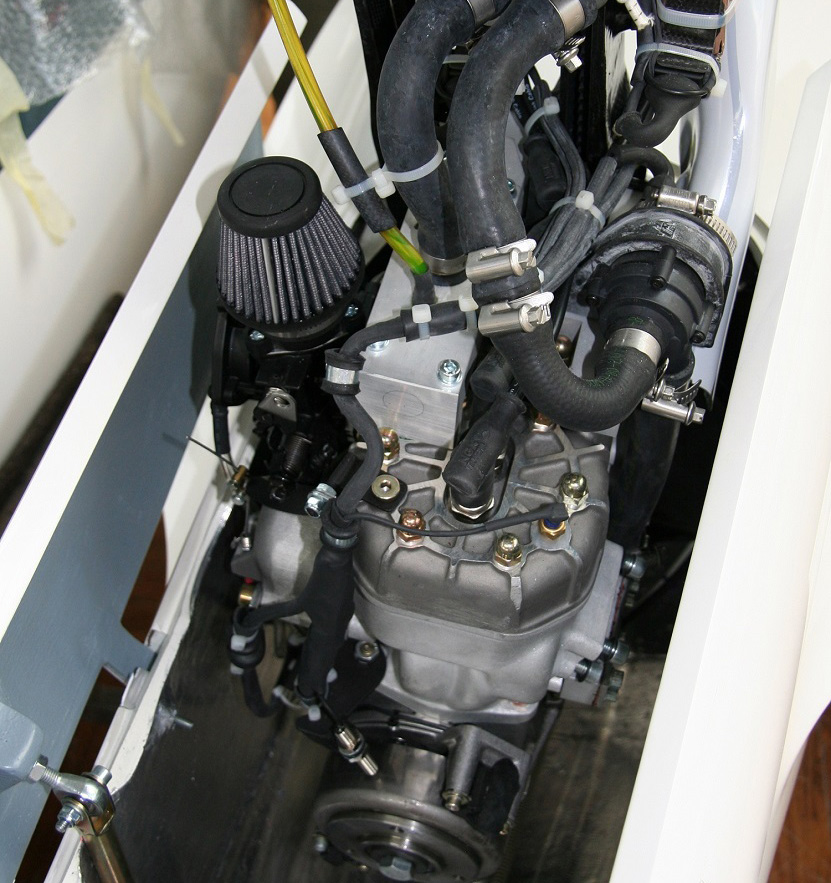

Flying like James Bond 🙂
The jet engine was developed for HpH by former MTU engineers. It’s size, weight, thrust and fuel consumption have been tailored especially for the use in a glider. So why should you choose our JET propulsion unit?
1. Low weight: System weight of less than 10kg (22 lbs)
2. Wide speed range: It allows speeds ranging from slow climbing to glider VNE while keeping constant thrust throughout the velocities.
3. User friendly operation: Advanced electronics automatically control the start-up/shut-down?sequence, thrust regulation as well as the retraction of the whole unit. There’s no need for choke, propeller brake, decompression levers and other controls. Operate with a single switch, power-up with a single knob!
4. No vibrations: Cruising with a jet (engine) is pleasant, silent and you don’t feel any vibrations in the cockpit. Not even the best propeller systems can compete!
5. Maintenance-free & easy to install: Disassemble in 5 minutes using standard tools, pack in a small and light package, send to us for inspection and keep on gliding in the meantime.
6. Special software for your local conditions: Gliding in Sweden or in Australia? Get your customized software settings!
7. Optimal fuel consumption of 17l/100km (6gal/100nm) – A virtually maintenance-free engine with reasonable operating costs.

With the introduction of the Shark 304ES, HPH move into the electric sailplane arena. Its experience with powered sailplanes and partnership with LZ Design continue the approach of working with the best companies to bring the Shark 304ES to market quickly and with a very high “out-of-the-box” product maturity.
The Shark 304ES delivers a significant battery-powered self-retrieve capability of approximately 80 km’s which is more than enough to get you to an airfield or in many cases back to soaring conditions or to your home base.
Using experience gained during development on the Certified Front electric sustainer (FES) System, LZ Design were able to work with HPH to determine the best way of adapting the Shark sailplane to offer the electric “Self-Retrieve” capability.
The system uses 2 GEN2 LiPo batteries which each come with a dedicated balancing charger. One battery weighs ~15kg and only looses about 1% of its charge in a month. They still retain 70–80% of their charge after 1000 complete recharge cycles. Full charging takes about 6–8 hours. Typically charging time wpuld be 2-3 hours after flight. Installing the batteries takes about 5 minutes.
The LXNAV FES controller is left powered for the duration of the flight. After take-off, the FES power is enabled via a toggle switch, whereupon the FES system is ready to offer immediate thrust by rotating the knob clockwise. This knob controls the power level. Rotating anti-clockwise stops the motor. The blades are then parked automatically.
The FES propeller is interlocked to prevent inadvertent operation on the ground. The FES system automatically parks the blades and nose to ensure optimal aerodynamic performance.
The FES propeller blades are protected during transport or when on the airfield with a removable cover. The Cobra trailer nose cone incorporates cut-outs for the propeller during transit.
ES (ELECTRIC SUSTAINER) | |
Engine System | |
Battery technology | LiPo GEN2 system |
Battery weight | 2 x 14 kg /2 x 31 lbs |
Maximum Power | 23 kW |
Maximum RPM | 4.500 |
Engine Performance | |
Climb rate | 1.5–2 m/sec |
Range | 80 km |
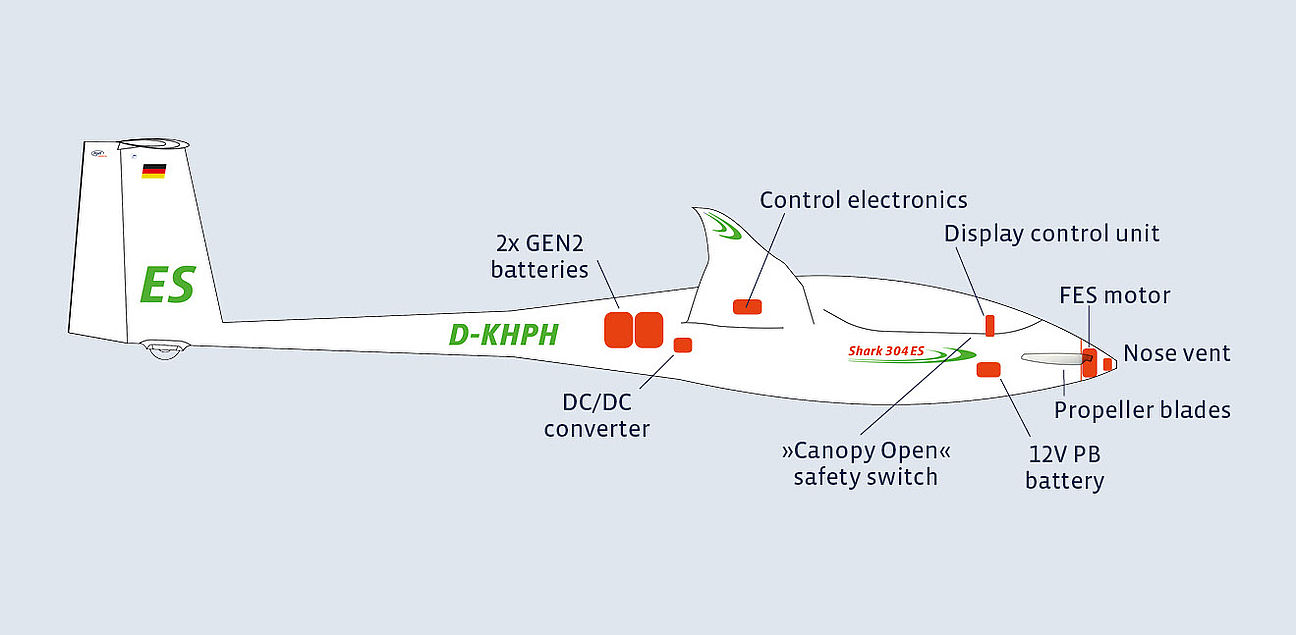
JS (jet engine) | MS (selflauncher) | ES (electric sustainer) | |
Geometry | |||
Wing span | 18 m (59 ft) | 18 m (59 ft) | 18 m (59 ft) |
Wing area | 11.74 m2 / 126.3 ft2 | 11.74 m2 / 126.3 ft2 | 11.74 m2 / 126.3 ft2 |
Aspect ratio | 27.43 | 27.43 | 27.43 |
Fuselage length | 6.79 m / 22.28 ft | 6.79 m / 22.28 ft | 6.79 m / 22.28 ft |
Profile | HPH xn2 | HPH xn2 | HPH xn2 |
Weights | |||
Empty weight | 355 kg / 783 lb | 395 kg / 870 lb | 365 kg / 805 lb |
maximum take-off weight | 600 kg /1323 lb | 600 kg / 1323 lb | 600 kg / 1323 lb |
Water ballast | 200 l / 53 US gal | 120 l / 32 US gal | 180 l / 48 US gal |
Min. wing loading | 36.2 kg/m2 / 7.4 lb/ft2 | 39.6 kg/m2 / 8.1 lb/ft2 | 37 kg/m2 / 7.6 lb/ft2 |
Max. wing loading | 51.1 kg/m2 /10.47 lb/ft2 | 51.1 kg/m2 / 10.47 lb/ft2 | 51.1 kg/m2 / 10.47 lb/ft2 |
Glide Performance | |||
Best glide ratio | > 50 | > 50 | > 50 |
at speed | 125 km/h / 67.5 kts | 125 km/h / 67.5 kts | 125 km/h / 67.5 kts |
min. sink rate (at min. weight) | 0.47 m/s / 93 ft/min | 0.49 m/s / 96 ft/min | 0.50 m/s / 98 ft/min |
at speed | 68 km/h / 37 kt | 71 km/h / 38 kt | 68 km/h / 37 kt |
Limitations | |||
Stall speed (at max. weight) | 88 km/h / 47.5 kt | 88 km/h / 47.5 kt | 88 km/h / 47.5 kt |
VNE | 263 km/h /142 kt | 263 km/h /142 kt | 263 km/h /142 kt |
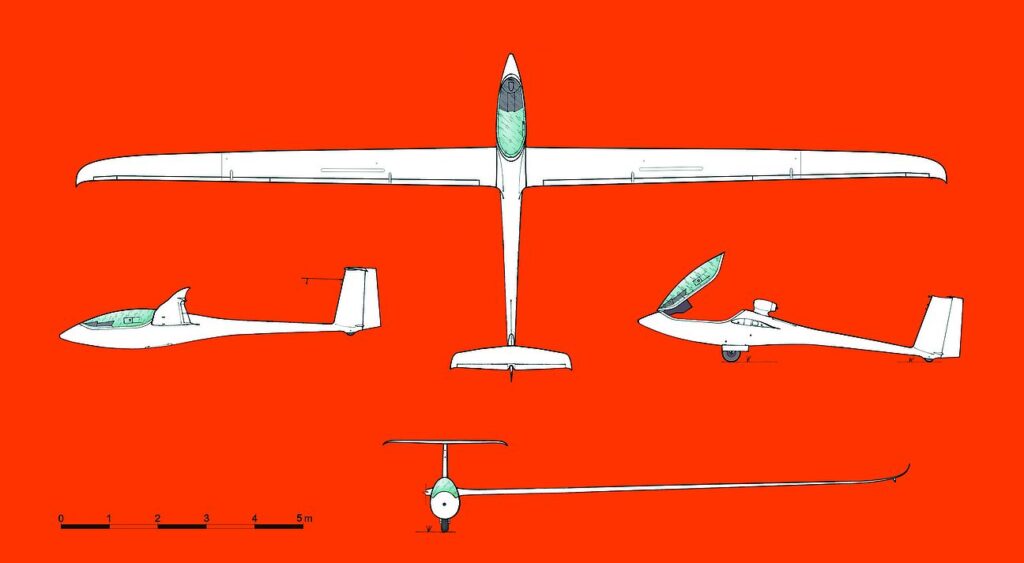
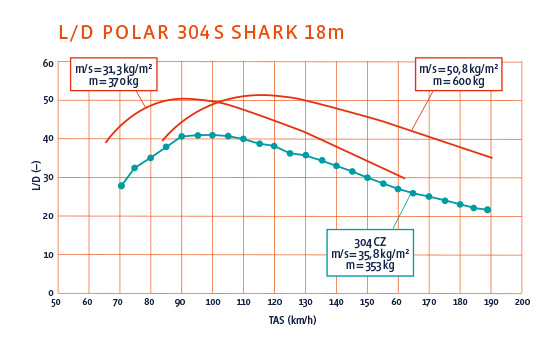

Our basic system package includes: